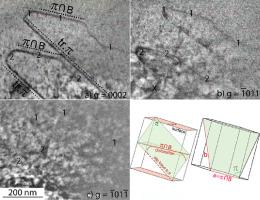当前位置:
X-MOL 学术
›
Acta Mater.
›
论文详情
Our official English website, www.x-mol.net, welcomes your feedback! (Note: you will need to create a separate account there.)
Mobility of 〈c+a〉 dislocations in zirconium
Acta Materialia ( IF 9.4 ) Pub Date : 2020-09-01 , DOI: 10.1016/j.actamat.2020.07.026 Thomas Soyez , Daniel Caillard , Fabien Onimus , Emmanuel Clouet
Acta Materialia ( IF 9.4 ) Pub Date : 2020-09-01 , DOI: 10.1016/j.actamat.2020.07.026 Thomas Soyez , Daniel Caillard , Fabien Onimus , Emmanuel Clouet

|
Plasticity in hexagonal close-packed zirconium is mainly controlled by the glide of dislocations with 1/3 Burgers vectors. As these dislocations cannot accommodate deformation in the [0001] direction , twinning or glide of dislocations, i.e. dislocations with 1/3 Burgers vector, have to be activated. We have performed in situ straining experiments in a transmission electron microscope to study the glide of dislocations in two different zirconium samples, pure zirconium and Zircaloy-4, at room temperature. These experiments show that dislocations exclusively glide in first-order pyramidal planes with cross-slip being activated. A much stronger lattice friction is opposing the glide of dislocations when their orientation corresponds to the direction defined by the intersection of their glide plane with the basal plane. This results in long dislocations straightened along which glide either viscously or jerkily. This direction governs the motion of segments with other orientations, whose shape is merely driven by the minimization of the line tension. The friction due to solute atoms is also discussed.
中文翻译:

锆中〈c+a〉位错的迁移率
六方密排锆的塑性主要受1/3 Burgers 向量位错的滑移控制。由于这些位错不能适应[0001]方向上的变形,必须激活位错的孪晶或滑移,即具有1/3 Burgers矢量的位错。我们在透射电子显微镜中进行了原位应变实验,以研究两种不同锆样品(纯锆和 Zircaloy-4)在室温下的位错滑动。这些实验表明,位错仅在一阶锥体平面中滑动,并激活交叉滑移。当位错的方向对应于由它们的滑动面与基面的相交所定义的方向时,更强的晶格摩擦力对抗位错的滑动。这导致长的位错变直,沿着它粘性或急促地滑动。该方向控制具有其他方向的线段的运动,其形状仅由线张力的最小化驱动。还讨论了由溶质原子引起的摩擦。
更新日期:2020-09-01
中文翻译:

锆中〈c+a〉位错的迁移率
六方密排锆的塑性主要受1/3 Burgers 向量位错的滑移控制。由于这些位错不能适应[0001]方向上的变形,必须激活位错的孪晶或滑移,即具有1/3 Burgers矢量的位错。我们在透射电子显微镜中进行了原位应变实验,以研究两种不同锆样品(纯锆和 Zircaloy-4)在室温下的位错滑动。这些实验表明,位错仅在一阶锥体平面中滑动,并激活交叉滑移。当位错的方向对应于由它们的滑动面与基面的相交所定义的方向时,更强的晶格摩擦力对抗位错的滑动。这导致长的位错变直,沿着它粘性或急促地滑动。该方向控制具有其他方向的线段的运动,其形状仅由线张力的最小化驱动。还讨论了由溶质原子引起的摩擦。



























 京公网安备 11010802027423号
京公网安备 11010802027423号